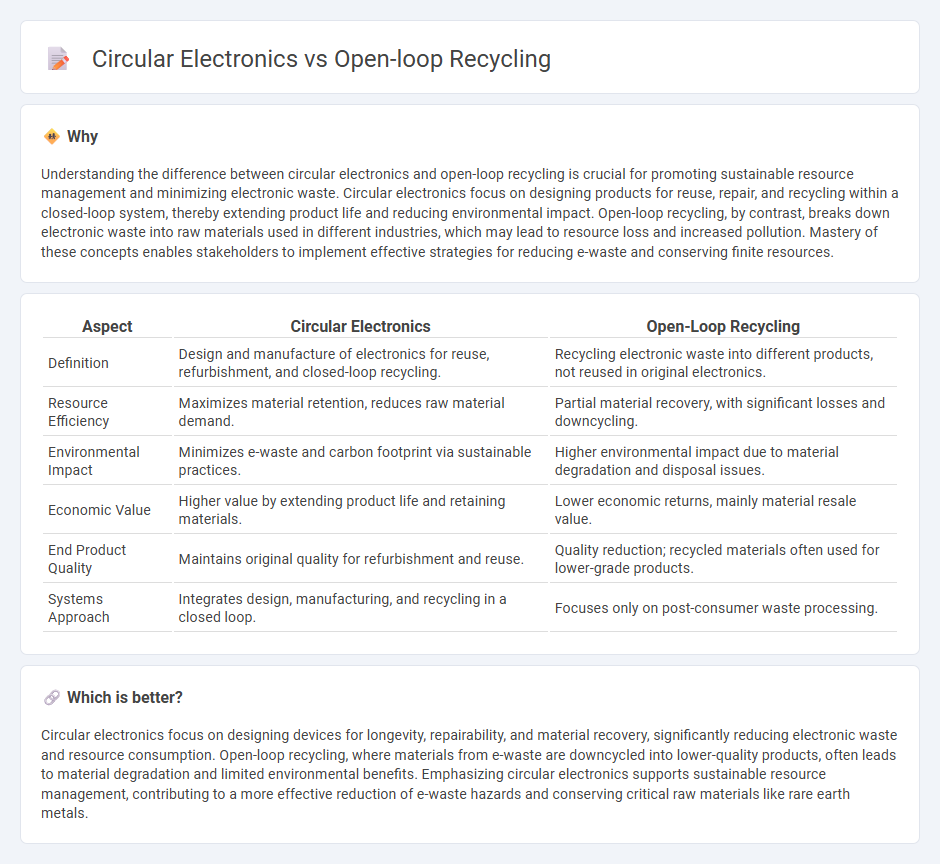
Circular electronics focus on designing devices to be easily disassembled, repaired, and reused, significantly reducing electronic waste. Open-loop recycling breaks down discarded electronics into raw materials for new products, often resulting in downcycled components with limited reuse potential. Explore deeper insights into how circular systems can transform e-waste management and sustainability in technology.
Why it is important
Understanding the difference between circular electronics and open-loop recycling is crucial for promoting sustainable resource management and minimizing electronic waste. Circular electronics focus on designing products for reuse, repair, and recycling within a closed-loop system, thereby extending product life and reducing environmental impact. Open-loop recycling, by contrast, breaks down electronic waste into raw materials used in different industries, which may lead to resource loss and increased pollution. Mastery of these concepts enables stakeholders to implement effective strategies for reducing e-waste and conserving finite resources.
Comparison Table
| Aspect | Circular Electronics | Open-Loop Recycling |
|---|---|---|
| Definition | Design and manufacture of electronics for reuse, refurbishment, and closed-loop recycling. | Recycling electronic waste into different products, not reused in original electronics. |
| Resource Efficiency | Maximizes material retention, reduces raw material demand. | Partial material recovery, with significant losses and downcycling. |
| Environmental Impact | Minimizes e-waste and carbon footprint via sustainable practices. | Higher environmental impact due to material degradation and disposal issues. |
| Economic Value | Higher value by extending product life and retaining materials. | Lower economic returns, mainly material resale value. |
| End Product Quality | Maintains original quality for refurbishment and reuse. | Quality reduction; recycled materials often used for lower-grade products. |
| Systems Approach | Integrates design, manufacturing, and recycling in a closed loop. | Focuses only on post-consumer waste processing. |
Which is better?
Circular electronics focus on designing devices for longevity, repairability, and material recovery, significantly reducing electronic waste and resource consumption. Open-loop recycling, where materials from e-waste are downcycled into lower-quality products, often leads to material degradation and limited environmental benefits. Emphasizing circular electronics supports sustainable resource management, contributing to a more effective reduction of e-waste hazards and conserving critical raw materials like rare earth metals.
Connection
Circular electronics promote sustainable design by prioritizing reuse, repair, and recycling of electronic components, reducing e-waste. Open-loop recycling in electronics involves converting discarded devices into raw materials for different products, supporting resource recovery but not direct material reuse. The connection lies in circular electronics aiming for closed-loop systems, while open-loop recycling provides an alternative method to reclaim valuable materials, complementing overall sustainability efforts in technology.
Key Terms
Material Downcycling
Open-loop recycling in electronics refers to the process where recovered materials are repurposed into products of lower quality or different functions, often leading to material downcycling and reduced lifespan. Circular electronics aims to maintain the value and functionality of materials through design, reuse, and high-quality recycling processes that minimize resource loss and environmental impact. Explore innovative strategies and technologies transforming material downcycling to enhance sustainability in electronic waste management.
Product Lifecycle
Open-loop recycling involves converting electronic waste into raw materials for different products, often leading to quality degradation and shorter lifecycles, whereas circular electronics emphasize designing devices for repeated reuse, repair, and refurbishment to extend the original product's lifespan. Circular electronics prioritize sustainable materials, modular design, and end-of-life recovery processes that maintain product value within the same lifecycle. Discover more about how circular electronics reshape product lifecycle management for sustainability.
Closed-Loop System
Closed-loop systems in circular electronics emphasize continuous material recovery and reuse, minimizing waste by converting used products back into raw materials for new manufacturing. Open-loop recycling, conversely, redirects materials into different products, often resulting in quality degradation and limited reuse potential. Explore the benefits and mechanisms of closed-loop systems to fully understand their impact on sustainable electronics.
Source and External Links
What is Open Loop Recycling? - Definition - oboloo - Open loop recycling is the process of taking waste materials and using them to create new products, often different from the original items, which helps reduce waste, conserve resources, and lower greenhouse gas emissions.
Quick Guide to Open Loop vs Closed Loop Recycling - AAA Polymer - Open-loop recycling refers to recycling materials into new raw materials and products that are different from their initial purpose, such as converting recycled plastic bottles into fleece jackets.
5.2. Recycling: open-loop versus closed-loop thinking | EME 807 - Open-loop recycling means materials are not recycled indefinitely but eventually exit the cycle as waste, often experiencing quality degradation and resulting in down-cycling.
 dowidth.com
dowidth.com